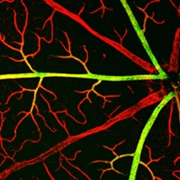Research on blood vessel proteins holds promise for controlling 'blood-brain barrier'
13 Dec 2012
Working with mice, Johns Hopkins researchers have shed light on the activity of a protein pair found in cells that form the walls of blood vessels in the brain and retina, experiments that could lead to therapeutic control of the blood-brain barrier and of blood vessel growth in the eye.
 Their work reveals a dual role for the protein pair, called Norrin/Frizzled-4, in managing the blood vessel network that serves the brain and retina.
Their work reveals a dual role for the protein pair, called Norrin/Frizzled-4, in managing the blood vessel network that serves the brain and retina.
The first job of the protein pair's signalling is to form the network's proper 3-D architecture in the retina during foetal development. The second job, after birth, is to continue signalling to maintain the blood-brain barrier, which gives the brain an extra layer of protection against infection transmitted through the circulatory system.
The Hopkins researchers say results of the study, published online in on 7 December in Cell , could have treatment implications for disorders of the retinal blood vessels caused by diabetes, and age-related loss of central vision.
They also could help clinicians develop a way to temporarily increase the penetrability of the blood-brain barrier, allowing critical drugs to pass through to the brain, says Jeremy Nathans, MD, PhD, a Howard Hughes researcher and professor of molecular biology and genetics at the Institute for Basic Biomedical Sciences at the Johns Hopkins School of Medicine.
Scientists already knew that Frizzled-4 is a protein located on the surface of the cells that create blood vessel walls throughout the body. Genetic mutations that cause Frizzled-4's absence in mice and humans create severe defects in blood vessel development, but only in the retina, the light-absorbing sheet of cells at the back of the eye. Retinal tissue consumes the most oxygen per gram than any other tissue in the body. Therefore, three networked layers of blood vessels are required to fulfill its oxygen needs. So blood vessel defects in the retina generally starve it of oxygen, causing blindness.













.jpg)






.jpg)









